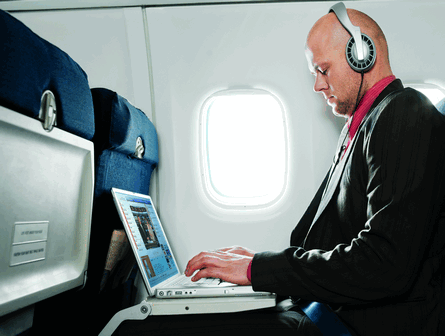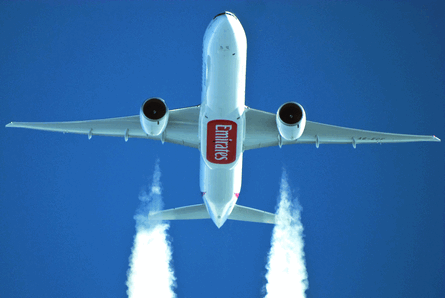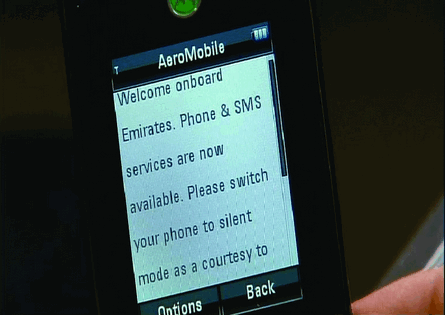As the industry struggles in the face of skyrocketing fuel prices, the siren song of revenue generation is luring a growing number of airlines to commit to new in-flight entertainment and connectivity services.
Carriers renowned for their in-flight offerings and others eager to boost high-end business traffic are investing significantly in new technology to ensure brand differentiation.
In past downturns, airlines often sidelined new IFE and connectivity projects to focus on core activities and cost-cutting. In the aftermath of 9/11, for example, three major US carriers dropped plans to equip their aircraft with Connexion by Boeing, the now-defunct high-speed internet and live television service. Such offerings were not viewed as essential.
Those ambitious enough to take the Connexion leap - Lufthansa, for example, equipped a sizeable chunk of its fleet with the system - found themselves burdened with heavy fuselage-mounted antennas when the service was discontinued.
But as thousands of industry executives prepare to descend next week on Long Beach, California for the World Airline Entertainment Association (WAEA) conference and exhibition, and Aircraft Interiors Expo, a new found optimism is evident.
"We have record numbers of people registered for our conference and trade show. There are obviously a lot of buyers and potential buyers," says WAEA executive director Richard Owen.
 |
|---|
© Panasonic |
Interactive IFE platforms that allow handheld devices to be introduced on a plug-and-play basis, live television and portable video players are all garnering significant attention, while connectivity - offered either though embedded IFE systems or as an add-on service - is attracting even the most staunchly traditional low-cost operators.
PROOF IN NUMBERS
The airline industry is likely to spend more money this year on IFE and communication technologies than ever. Consultancy firm Inflight Management Development Centre (IMDC) says 2008 will probably be a record year in terms of airline expenditure for the sector. For 2007-12, more than 3,000 of the 16,000 commercial jets that are expected to be delivered will be line-fitted with IFE. IMDC's forecast takes into account connectivity, not just classic IFE.
"The melding of traditional IFE hardware and connectivity started three or four years ago, perhaps with Connexion by Boeing," says Owen. "Compatibility across platforms, open architecture and a reduced cycle time to the market are but a few of the factors driving it."
While portable IFE had a relatively small base of $75 million for 2007, IMDC expects double-digit growth for the next two to three years. Companies such as AirVod, IMS and Mezzo are attracting portable business from airlines that want to avoid the often large capital expenditure associated with installed IFE.
A number of key drivers are contributing to the overall boom. Manufacturers are developing systems that are lighter, more robust and less costly to install and maintain than in years past. And system reliability difficulties, which plagued interactive IFE systems in the 1990s, have been largely addressed.
"Are we at 100% reliability? Probably not," says Owen. "Something that is so complicated from an engineering standpoint isn't going to be perfect, but reliability is greatly improved, and will continue to be as industry advances are made."
Additionally, emerging markets are ensuring long-term business. Carriers from the Middle East, for example, have committed to massive aircraft orders that will have IFE.
Dubai-based Emirates last year contracted Panasonic Avionics for $500 million to supply eX2 IFE systems for its existing fleet and new aircraft purchases, as part of an investment of more than $600 million in new in-flight products and services.
 |
|---|
© Aviation-Images.com |
"All airlines are suffering with the fuel [prices], ourselves included. It erodes profitability of airlines. However, Emirates has always believed that a great product will protect your yield. It will attract passengers," says Emirates vice-president for passenger communications Patrick Brannelly.
"There is a saying: 'If you think education is expensive, see how expensive not educating your kids is'. The same goes for products. If you think products are expensive, see how expensive it is if you don't offer a good product."
Panasonic Avionics director of strategic product marketing David Bruner says severely distressed carriers "will have to make hard decisions", but those in stronger positions, which are updating their fleets with more fuel-efficient aircraft, "are going for the best services in the marketplace, the best entertainment and the best new communications systems". He says despite industry woes, there has been "no change in business for Panasonic".
Thales makes a similar market assessment. At the Farnborough air show - where Thales announced IFE system orders from Indian regional start-up Star Aviation and a follow-on order from Malaysian carrier AirAsia X - Thales Avionics chief executive Brad Foreman said the firm is seeing only limited impact on its business from airlines' belt-tightening.
"Airlines are parking their less-efficient aircraft, which didn't have IFE. The flipside of that equation is that most airlines want new aircraft to replace the less fuel-efficient aircraft," he said. "It has given us very few challenges and plenty more opportunities."
While there is business to be had in the USA, airlines are distracted, says LiveTV vice-president of sales and marketing Mike Moeller. "Every penny is being watched carefully and conserved. So [airlines are saying] 'if you want to put this equipment on my aircraft, and the added weight, it has to pay for itself'.
"You have to come [to the boardroom] with your 'A' game. You'd better come with capital and you'd better come with a strong story as a vendor. That's weeding people out quickly."
 |
|---|
© Virgin America |
Even as they scale back in-flight amenities in economy class, some US majors are boosting premium-class offerings. Star Alliance member United Airlines and future partner Continental Airlines are equipping the premium cabins of their international fleets with fully lie-flat beds and Panasonic IFE systems. Significantly, the systems support Apple iPod and iPhone connectivity. Audio and video is sent from the portable devices to the IFE platform, which in turn sends power to the iPod or iPhone.
Such blending of functionality could spell big revenue-generating opportunities for carriers. Once broadband gets fully up and running on commercial aircraft, the iPhone or iPod touch could become a gateway to the iTunes music store, suggests one industry observer. "This is the kind of upfront investment that pays major dividends if you put this product in economy as well - an unlimited selection of movies to watch or rent with a brand-new revenue stream for profit sharing with Apple."
DIFFERENT PATHS
At present, airlines have several connectivity options. They can select a relatively basic service that will allow passengers to make mobile calls and send SMS messages and emails via personal devices like BlackBerrys using Inmarsat's L-band satellites, or they can offer travellers a full-blown high-speed service using Ku-band satellites or an air-to-ground network in the USA.
Thales has outlined a connectivity strategy that uses Inmarsat's SwiftBroadband satcom network to allow passengers to use standalone solutions and applications integrated into the on-board IFE. The recent launch of Inmarsat's third I-4 satellite means SwiftBroadband will shortly be accessible worldwide, except in the extreme polar regions.
Panasonic, on the other hand, is developing a Ku-band-based in-flight broadband product called eXConnect. "It's always good if airlines have installed IFE for connectivity, but there are airlines looking at this - some that have made an incorrect choice of IFE supplier in the past - that now want to augment it. Absolutely, we will install [eXConnect] if Thales or Rockwell Collins [IFE] is on board or as a standalone system," says Bruner.
As these two dominant IFE hardware manufacturers make their foray into connectivity, other companies have made visible strides in the sector. In March, Emirates enabled the first authorised in-flight mobile phone call on a commercial flight, following installation of technology developed by Arinc/Telenor joint venture AeroMobile that allows passengers to use their own GSM or GPRS-enabled devices while the aircraft is airborne.
AEROMOBILE COMMITMENTS
AeroMobile also has commitments from Qantas, Turkish Airlines and Saudi Arabian Airlines, while its rival, Airbus/Sita partnership OnAir, is on trial on Air France and TAP Air Portugal, and preparing to go live on Ryanair.
The cost to passengers is similar to international roaming rates. Airlines get paid from a share of the revenue generated from the cabin.
 |
|---|
"Clearly Ryanair is going to push this as revenue generation and I have full confidence in its ability to market this to passengers," says OnAir chief executive Benoit Debains.
He is convinced that once people get a taste of in-flight mobile phone connectivity, they will come to expect it. There are "applications that people haven't started to think about", he says, like the ability to access information about each flight, using a mobile phone as a tool for rebooking and mobile check-in.
In the USA, where in-flight mobile phone use is banned, some operators are taking their cues from the likes of Virgin America, which charges passengers for meals and movies over its "Red" IFE system (a combination of Panasonic hardware and CoKinetic software) and will soon support Aircell's air-to-ground internet service, Gogo.
American Airlines and Delta Air Lines have agreed to offer Gogo to passengers at a cost. American is testing the service on an initial fleet of 15 transcontinental Boeing 767s with the goal of rolling it out across its domestic fleet if usage and reliability proves robust. Delta has committed to offer Gogo on its domestic mainline fleet of more than 330 aircraft.
The pricing is similar to what consumers pay on the ground at a Wi-Fi hot spot: the airlines charge a flat fee of $12.95 for flights in excess of 3h and a $9.95 fee for trips of 3h or less.
"We're making it such a compelling financial proposition that the airline has really no alternative but to move forward," says Aircell chief executive Jack Blumenstein.
"We really have cracked the code in being able to show the airlines why the approach we're taking is both overwhelmingly attractive financially as well as providing some good news to the marketplace."
Blumenstein predicts broadband connectivity will provide "hundreds of millions of revenue dollars over the life of the relationship".
Alaska Airlines and Southwest Airlines, meanwhile, intend to test Row 44's connectivity system, which leverages existing Ku-band satellite networks to offer global coverage. Southwest says the service, which is expected to support high-bandwidth functions, including streaming video, will be tested in the fourth quarter. "Just what's the best price point for our customer - that's the part we're still working through," says the carrier.
SPONSORSHIP DEALS
The low-cost airline is not alone. Everything from basic fee-for-service to more elaborate advertising and sponsorship deals are being explored by the world's operators. "All the different carriers are looking at the different pricing models on how they will deliver IFE and connectivity," says Owen.
LiveTV's in-flight television service is free on parent JetBlue Airways' fleet, while Frontier Airlines charges for the service. "We know how many people will swipe their credit card on a given flight length to a given city because of that we have a high degree of certainty on the passenger pay-TV model," says Moeller.
But like other hardware suppliers, LiveTV is also making headway in bringing connectivity in-flight. The company, which owns a 1MHz narrowband licence, is able to offer basic in-flight connectivity across JetBlue's fleet as well as those of Continental Airlines and Frontier, which have also committed to adopting the email and messaging service.
Should the marketplace for broadband prove a lucrative proposition, LiveTV will be "on the sidelines, warmed up and ready to go into the game", says Moeller.
According to research firm MultiMedia Intelligence, the potential windfall for broadband providers could be substantial. The market for in-flight broadband service, it says, is poised to grow to $936 million in passenger revenue in 2012, up from initial revenue of $6.6 million this year. Similarly, the market for in-flight live direct broadcast video is projected to grow from $87 million in 2007 to $913 million in 2012.
Source: Flight International
















